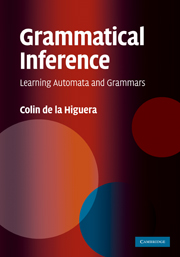Book contents
- Frontmatter
- Contents
- Preface
- Acknowledgements
- 1 Introduction
- 2 The data and some applications
- Part I The Tools
- 3 Basic stringology
- 4 Representing languages
- 5 Representing distributions over strings with automata and grammars
- 6 About combinatorics
- Part II What Does Learning a Language Mean?
- Part III Learning Algorithms and Techniques
- References
- Index
5 - Representing distributions over strings with automata and grammars
from Part I - The Tools
Published online by Cambridge University Press: 05 July 2014
- Frontmatter
- Contents
- Preface
- Acknowledgements
- 1 Introduction
- 2 The data and some applications
- Part I The Tools
- 3 Basic stringology
- 4 Representing languages
- 5 Representing distributions over strings with automata and grammars
- 6 About combinatorics
- Part II What Does Learning a Language Mean?
- Part III Learning Algorithms and Techniques
- References
- Index
Summary
If your experiment needs statistics, you ought to have done a better experiment.
Ernest Rutherford‘I think you're begging the question,’ said Haydock, ‘and I can see looming ahead one of those terrible exercises in probability where six men have white hats and six men have black hats and you have to work it out by mathematics how likely it is that the hats will get mixed up and in what proportion. If you start thinking about things like that, you would go round the bend. Let me assure you of that!’
Agatha Christie, The Mirror Crack'd from Side to Side (1962) © Agatha Christie Ltd, A Chorion Company, all rights reservedInstead of defining a language as a set of strings, there are good reasons to consider the seemingly more complex idea of defining a distribution over strings. The distribution can be regular, in which case the strings are then generated by a probabilistic regular grammar or a probabilistic finite automaton. We are also interested in the special case where the automaton is deterministic.
Once distributions are defined, distances between the distributions and the syntactic objects they represent can be defined and in some cases they can be conveniently computed.
Distributions over strings
Given a finite alphabet Σ, the set Σ* of all strings over Σ is enumerable, and therefore a distribution can be defined.
- Type
- Chapter
- Information
- Grammatical InferenceLearning Automata and Grammars, pp. 86 - 115Publisher: Cambridge University PressPrint publication year: 2010



